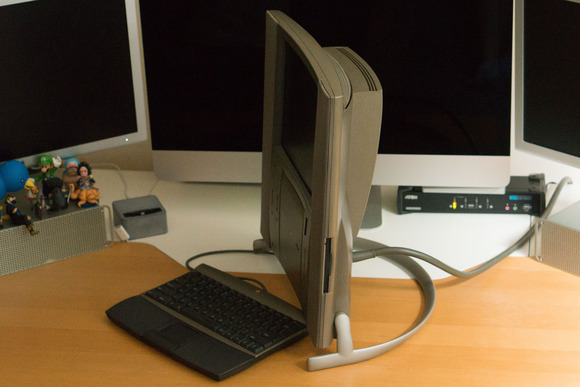Introducing the legendary 20th Anniversary Macintosh
Built in the late 90s, the Twentieth Anniversary Macintosh, or “TAM” for short, was described as the precursor, or grand-daddy, of the modern iMac, and rightfully so, as the similarities between the two machines are tangible. The TAM, built to celebrate 20 years of Apple innovation, was in many respects a novelty. Only few thousand units were manufactured, with a price tag set at a staggering $7,499.
 Image courtesy of MacWorld
Image courtesy of MacWorld
With very few people having heard of TAM’s existence, and even fewer lucky enough to own one, this device embodied every aspect found in modern all-in-one desktop systems, especially the Apple iMac.
The device was built during Steve Jobs’ absence from the company, almost anticipating Jobs’ “Digital Hub” philosophy which lead to the modern and very flat iMac. Having said that, MacWorld’s Christopher Phin, which was lucky enough to receive one of these very rare units, describes the TAM as a “complete aberration”, though in a good way. For its time, the TAM was a fascinating product, its design was very unlike any previous Apple desktop product, and most certainly unlike any other desktop PC on the market. It was odd and very advanced for a desktop system built in the 90s, a period in which computers were bulky and deep, and flat panel LCDs were still an expensive novelty, perfectly fitting TAM’s impossibly thin, user-facing, slightly concave case, and its prohibitive price tag.
Speaking of TAM’s thinness, this feature in particular appeared almost decisive of the later models of the iMac, as they use a similar trick to create the illusion of a flat surface, by using a curved back designed to provide hiding room for all internal hardware.
The dark metallic finish of the TAM makes it even more odd looking and somewhat alien, or even slightly “cyberpunk”, by looking at the many lines, crevices and details on the front and the back of the machine.
By this token, it’s very hard to place this device in a particular era, without at least some obvious clues, such as the CD-ROM drive, built upright, into the front of the unit, below the display. The optical drive is designed to work independently from the rest of the computer if needed be, which was a common thing in the early days, to many internal CD-ROM drives, featuring playback controls to play, skip, pause and stop CD tracks.
The sound system built into the TAM included Acoustimass speakers by BOSE, and an external subwoofer, able to deliver tremendous sound quality, very uncommon to desktop computers.
What was even more amazing about this device was how ahead of its time it was in regard to multimedia. The back of the unit featured connectors for AM/FM radio, as well as TV cables, which would allow the unit to function as both a TV and a radio, through cards built onto the logic board.
While this odd device was by all means an “executive toy”, as Phin puts it, we can’t help but concur that the TAM embodies all the “...daringness and excess of Apple in the ‘90s...”.
Such excessive product, both in terms of design and specs, required also a quite different approach to delivery. Each unit, in fact, was not delivered by the typical UPS truck driver and dropped at a doorstep. Each order was delivered by limousine, and the unit was brought in, unpacked and assembled by tuxedo-wearing personnel, would would also provide instructions on how to operate the machine.
When compared to a modern iMac Retina 5K, this machine looks certainly ancient, however the appeal is undeniable and intriguing, as a device that would still provide a thrill to the enthusiast.